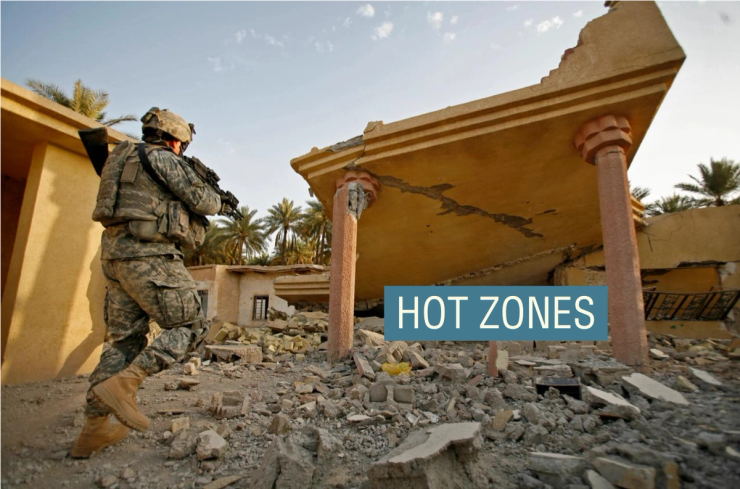The Author
Peter Schwartzstein is a climate-focused journalist who is a Global Fellow at the Wilson Center. The following is an edited excerpt from his new book, The Heat and the Fury, which is out Tuesday. Pre-order it here.
Peter’s view
We think Western democracies are immune from climate violence. They’re not.
A lot of the risk in richer countries depends on climate crises elsewhere. But from within the West as well, we can see the makings of significant climate-related chaos. Europe and the United States already experience more crime during periods of the kind of extreme weather that climate change makes much more likely. Plenty of our own economic sectors could take major, possibly existential hits—to uncertain societal effect. And though the green transition may be an economic boon overall, it will not be possible without generating losers at home. The fact that those losses are unevenly distributed is already providing rich pickings for demagogic politicians.
In this chaotic, potentially more violent world one might imagine that we will have greater need of militaries. Early evidence certainly seems to bear that out, with troops from scores of nations now called upon to help during natural disasters, and security officials girding themselves for extra climate-related challenges. “I think it’s pretty clear that even modest sea level rise will trouble North America and Europe no end,” said James Woolsey, who directed the CIA during the Clinton administration. “People who don’t get this should read more.”

For a start, they will be called upon to help tackle climate change fallout. In many countries, they already are. In the United States, members of the National Guard devoted 172,000 days to fighting fires in 2021, about 10 times more than they did in 2019. In Switzerland, soldiers have airlifted water to cows high up in the Alps over several recent summers, their ordinarily plentiful watering holes scorched into nothingness. The Swedish air force actually has bombed forest fires into quiescence. (Like blowing out candles on a cake, the shock waves can douse flames.)
In conversation with strategic planners from a dozen different militaries, many have come across as deeply ambivalent about these new responsibilities. In 2022, Slovenia delivered a timely reminder of the difficulty that smaller states might experience in marrying new duties to their core missions. With the country riven by wildfires and much of the military deployed to fight them, the government canceled a $300-million-plus deal to retool its forces with armored personnel carriers, a deal that policymakers had deemed necessary in light of its newly threatened near-neighborhood. But, as the challenge mounts, militaries are unlikely to have much choice. “The reality is that this is just a big part of national security,” said Woolsey.
Similarly, militaries will be required to respond to new crises in new places and possibly all in ways that they cannot yet anticipate. The Arctic is probably the best-known “climate arena”—and the one that, back in the 1990s, helped interest the likes of the Pentagon in climate’s national security implications in the first place. Melting ice floes may free up the strategic Northwest Passage while thawing open geographically sensitive and materially valuable waters which navies must patrol. In its assessment of challenges to US national security through 2040, the National Intelligence Council expects increased military activity “as Arctic and non-Arctic states seek to protect their investments, exploit new maritime routes, and gain strategic advantages.” Russia, it notes, has many more icebreakers than all Western states combined. However, almost every military is wrestling with a changing strategic landscape, or soon will be.
All the while, militaries may find it increasingly difficult to perform even their day-to-day duties. More bases are being struck by floods, rendering them useless for months or more at a time, as at Nebraska’s Offutt Air Force Base, which is home to the US Strategic Command and which was inundated in 2019. Others must contend with fiercer fires, more regular sandstorms, and stronger hurricanes, all of which have ground operations to a halt for extended periods. After the fires and mega-floods in September 2023, US and Greek officers determined that the jointly used helicopter base at Stefanovikeio, in the shadow of Mount Pelion and its devastating floodwaters, was too vulnerable for future use. Others still are increasingly unfit for purpose due to extreme heat stress.
In recent years, militaries have experienced an epidemic of munitions depots exploding in the heat, and, in some instances, of planes struggling to take off in inhospitable conditions. Critically, many militaries are struggling to keep their troops alive in these conditions, with 3,000 reported cases of heatstroke and heat exhaustion in US forces in 2018 alone, and to keep their vehicles serviceable in temperatures for which they were not designed. There is nothing quite like watching a bunch of American special forces soldiers pour out of a Humvee in Mosul and greet the 110-degree-Fahrenheit exterior as if it were an atmospheric cool bag for you to grasp the sauna-like properties of their equipment.
Officers suggest that Western militaries, which are generally more adaptable, may be able to adjust their practices, equipment, and infrastructure accordingly. But they—and plenty of their “poor country” peers—question the abilities of some less affluent, more regimented forces to do likewise. And that, at a time when those militaries may be called upon to manage the many kinds of security fallout described throughout this book, should keep their own governments’ officials awake at night, officers suggest. “The militaries of the Third World or the Global South are very ill-prepared to respond,” wrote Munir Muniruzzaman, a retired Bangladeshi major general and chairman of the Global Military Advisory Council on Climate Change, via email in early 2024. “Since there is not much understanding of the [climate] threat itself, so the policies have not been geared to the procurement policies of the militaries to prepare them or to tool them for this kind of task.”
Finally, to compound this complex mess, militaries will come under stronger pressure to decarbonize themselves, a requirement from which they are exempt under existing global climate legislation. That is likely necessary, given how emissions-heavy many of them are. Decarbonizing the military need not be strategically bad, either. From Afghanistan to Iraq, oil convoys were frequently the very exposed, very explosive logistical underbellies of American operations. NATO forces sustained at least one casualty for every 24 fuel convoys in those countries, according to an official at the organization, a statistic that, given the force’s thirst for gasoline, may have added up to hundreds of deaths.
Yet even some generals who favor greener approaches caution against pushing militaries to move too far, too fast, particularly at a time when they have so much of the above to consider. “Regions or states or countries that are in conflict are not going to be thinking about this, because it’s more important to win the fight,” said Richard Nugee, a recently retired British lieutenant general who was until 2021 the UK military’s lead on all things climate. “Don’t think I’m going to sacrifice operational advantage to be greener. We’re paid to win a war. ”


